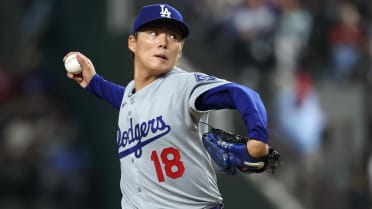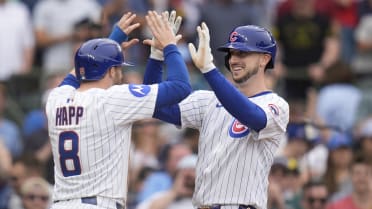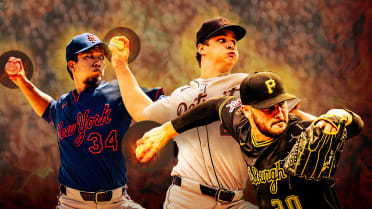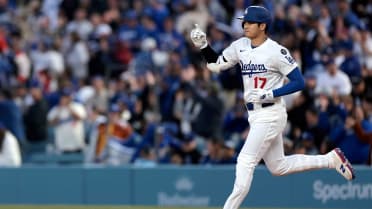CHICAGO -- Going into this year's MLB Draft, word was out that the Cubs were targeting options in every demographic of player type. Chicago put that on display with its first two selections, pulling from both the collegiate and high school pools to begin building up its prospect inventory.
After picking Kansas State lefty Jordan Wicks in the first round of the Draft on Sunday night, the Cubs selected prep infielder James Triantos to open their Day 2 picks on Monday. Then came high school lefty Drew Gray (Round 3) and Arkansas center fielder Christian Franklin (Round 4). Four picks, four boxes checked.
“We don’t have much time to reflect on it yet,” Dan Kantrovitz, the Cubs’ vice president of scouting, said with a laugh. “We’re already getting ready for [Day 3].”
The Draft's second day included picks from Rounds 2-10, with the remainder of the event taking place on Tuesday (Rounds 11-20).
Here is a breakdown of the Cubs' Day 2 selections:
Round 2, 56th overall: James Triantos, 3B, James Madison High School (Vienna, Va.)
Notable skills: The 18-year-old Triantos -- ranked No. 78 on MLB Pipeline's Top 250 Draft prospects list -- is highly touted for his bat, but his position is to be determined. The Cubs announced the right-handed batter as a third baseman in the Draft, but Kantrovitz said the team will “be open-minded” about his defensive future. If Triantos does blossom at third, with developing power to go with a contact-based offensive approach, MLB.com's Jonathan Mayo said he has heard from scouts that the ceiling could be an "Alex Bregman-ish comp."
Triantos only struck out twice in his senior season for the Warhawks, who won the 6A state championship with him starring both as a pitcher and shortstop. Triantos hit over .700 with a single-season school record for home runs (11). He's committed to the University of North Carolina.
Fun Fact: Triantos became the highest draftee out of James Madison High since the Padres took pitcher Jay Franklin in the first round of the 1971 MLB Draft.
Quotable: "[Our scouts] just came back raving about James' bat, his bat speed, his ability to control the zone, his plate coverage. It seemed like every time he made contact, it was loud, hard contact. He's driving the ball out to right-center. He's showing pull power. They just couldn't stop raving about James offensively." -- Kantrovitz
Round 3, 93rd overall: Drew Gray, LHP, IMG Academy (Bradenton, Fla.)
Notable skills: Gray was a two-way player in high school, but his future appears to rest on the mound. The 6-foot-3 pitcher is a "projectable" lefty with a high-spin fastball and a pair of breaking pitches (slider and curve). While there have been command issues, the tools are there for him to grow into a power arm. The Cubs see Gray as a starting pitcher down the road. In seven appearances this season, Gray struck out 41 of the 80 batters he faced and turned in a tidy 1.88 ERA with a .129 opponents' average. Gray (No. 179 on Pipeline's Top 250 Draft prospects list) is committed to Arkansas, where his older brother, Evan, pitches as well.
Fun fact: While Gray was picked out of IMG, the southpaw is originally from Illinois. Gray attended Belleville East High School in southwest Illinois (an eastern suburb of St. Louis) before transferring to IMG Academy for more exposure.
Quotable: "He's got just natural arm-side run and plus movement on his fastball, and his curveball is a hammer. I mean, it's one that's got late bite. The way that it enters the zone, it's a really tough pitch to pick up, and from kind of that same arm slot and arm path from his fastball. It's a pretty lethal combo." -- Kantrovitz
Round 4, 123rd overall: Christian Franklin, OF, Arkansas
Notable skills: According to MLB Pipeline's scouting report on Franklin, the 21-year-old boasted "some of the best all-around tools" in the collegiate class in this Draft. Franklin was ranked No. 52 on Pipeline's Top 250 Draft prospects list and had the makings of a possible first-rounder or second-rounder. Given that the Cubs landed him in the fourth, Callis said it has the potential to be "a steal" for the North Siders. In 61 games this year, Franklin hit .274/.420/.544 with 11 steals, 13 homers, 15 doubles, 44 walks, 54 RBIs and 55 runs scored. There is some swing-and-miss in Franklin's approach, but he uses the whole field as a hitter and could stick as a center fielder.
Fun fact: Dating back to 2015, Arkansas has had three center fielders taken in the first four rounds of the MLB Draft. Franklin joined Andrew Benintendi (first round, 2015) and Dominic Fletcher (second round, 2019) on that list.
Quotable: "There's not too many guys in the Draft where you can just sort of put your stamp on it and say, 'He's a true center fielder.' And we think Christian's that. And then you complement that with a power bat, and it's just like, 'Wow, that's not the type of talent that we see available in that part of the Draft normally.' Needless to say, we were pretty thrilled when he was there." -- Kantrovitz
Round 5, 154th overall: Liam Spence, SS, Tennessee
Notable skills: Spence was a high-average, on-base righty bat for Tennessee this season, hitting .336/.472/.459 in 65 games. He had more walks (54) than strikeouts (50) and finished his season with five homers, 11 doubles, 36 RBIs, 63 runs and 82 hits. Per MLB.com's Jim Callis, Spence is a "patient, contact-oriented hitter." That fits the mold for the Cubs, who could benefit from more contact-based bats in their system.
Fun fact: Spence is a native of Australia and his older brother, Josh, pitched for the Padres in parts of the 2011-12 seasons.
Quotable: “Our scouts had him evaluated as one of the better defensive shortstops in the country this year. And then his numbers in probably the premier baseball conference in the country, I think, speaks for itself. He’s got the ability to manage the zone. He definitely can square the ball up more often than most of his peers. And it’s not just sort of a contact approach. He can drive to the gaps, too.” -- Kantrovitz
Round 6, 184th overall: Riley Martin, LHP, Quincy University
Notable skills: Listed as a 6-foot-1, 215-pound left-hander, Martin was a strikeout artist over his collegiate career. This season, the pitcher fanned 152 batters in 78 2/3 innings, while walking 34 and posting a 3.55 ERA in 12 starts. He has a fastball-slider mix that helped him compile a school-record 30 wins over his career. In 308 1/3 innings at Quincy overall, the lefty had 352 strikeouts against 150 walks. The Cubs will keep an open mind about whether Martin’s future is as a starter or a reliever.
Fun fact: Martin topped 16 strikeouts in a start five times this season, with 19 being his single-game high on May 7.
Quotable: “Despite the competition that he was facing, we have his pitches evaluated as a couple fairly high-caliber professional offerings in that fastball-slider combo. He’s got a changeup. He didn’t really need to use it this spring.” -- Kantrovitz
Round 7, 214th overall: Parker Chavers, OF, Coastal Carolina
Notable skills: MLB Pipeline ranked Chavers, who will turn 23 on July 25, at No. 160 on the Top 250 Draft prospects list. This past season, the lefty-swinging outfielder pieced together a .318/.407/.477 slash line with 14 steals, 19 extra-base hits and 23 walks. Kantrovitz said Chavers has a “sneaky-good tool set” and the potential to stay in center. Chavers also logged a 13.2 percent strikeout rate after whiffing at a 19.2 percent clip in his 2018-19 seasons. Surgery to repair a torn labrum in his right (throwing) shoulder in December 2019 led to Chavers going undrafted in '20. He had been thought of as a potential first- or second-round pick before the injury. Chavers has plus speed and has shown improvement with making hard contact, but he will need to work on facing lefties.
Fun fact: Chavers was considered "the most decorated freshman" in Coastal Carolina's history, per the school's player bio. In '18, he was a Freshman All-American (Collegiate Baseball) and a second-team Freshman All-American (Baseball America, D1 Baseball and Perfect Game/Rawlings), plus other accolades.
Quotable: “Parker missed a little time due to an injury, but if you look at his performance -- and this was echoed by our scouting opinions -- he never really missed a beat and always performed out there on the field.” -- Kantrovitz
Round 8, 244th overall: Casey Opitz, C, Arkansas
Notable skills: Opitz was not in MLB Pipeline's Top 250 Draft prospects, but the catcher did rank 245th on Baseball America's pre-Draft rankings. MLB.com's Jim Callis called Opitz one of the best defensive catchers in this class. He has posted plus pop times and boasts arguably the best arm among catchers in the Draft. He has also been praised for his receiving and ability to work with pitchers. Where Opitz will need to keep showing improvement is in the batter's box. He hit .252 (.705 OPS) in four years for Arkansas and hit .257 (.713 OPS) in 55 games this season.
Fun fact: Opitz was previous drafted out of high school by Cleveland in the 27th round (822nd overall) in the 2017 Draft.
Quotable: "We thought Casey was the best catcher in the country. And I don’t think you’d find too many people that would disagree with that, to be honest, among guys who were close to college baseball. He managed a staff at Arkansas that was full of guys throwing 95-plus. And the way he could stick strikes and steal strikes, and be agile back there and essentially shut down a running game, it was pretty fun to watch.” -- Kantrovitz
Round 9, 274th overall: Chase Watkins, LHP, Oregon State
Notable skills: Watkins found a home in Oregon State's bullpen in '21, following previous stops with the College of Central Florida ('20) and Col Poly ('19). In 25 games this season, the 6-foot-4 lefty had 38 strikeouts against 15 walks with a 4.88 ERA. He features a low-90s fastball, plus a "good spin" curveball, per MLB.com's Jonathan Mayo. Watkins also has a slider and a changeup. He was not among Pipeline's Top 250 Draft prospects, but checked in at No. 284 for Baseball America.
Fun fact: Watkins is among the growing list of pitchers who have utilized Driveline Baseball near Seattle for velocity training. While there, he got his fastball up to 95 mph at times.
Quotable: “You don’t want to pigeonhole somebody if they have the chance to potentially start or go three times through an order. But I think the trend with him probably suggests that [the bullpen] is probably his best fit for now.” -- Kantrovitz
Round 10, 304th overall: Peter Matt, OF, Duke
Notable skills: After suiting up for Penn for four seasons, the 23-year-old Matt finished his collegiate career with Duke. The righty-swinging outfielder's calling card was power, as he launched 15 homers and posted a .566 slugging percentage in 54 games. Matt (6-foot-2, 220 pounds) split his time between right field and designated hitter, batting .297 with 12 doubles, 15 stolen bases, 23 walks, 70 strikeouts and a .924 OPS.
Quotable: “He’s got some thump in that bat. It was hard to get a look at him and kind of interpret that success when he was in the Ivy League. When he transferred to Duke in the ACC, we got a chance to see how that played against some top-notch pitching and competition. He just kept hitting.” -- Kantrovitz
Senior Reporter Jordan Bastian covers the Cubs for MLB.com. He previously covered Cleveland from 2011-18 and Toronto from 2005-10. Subscribe to his Cubs Beat newsletter.




